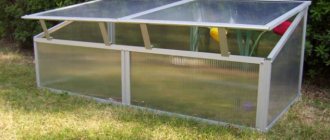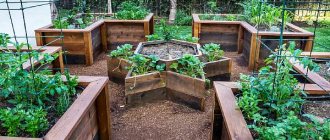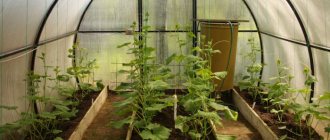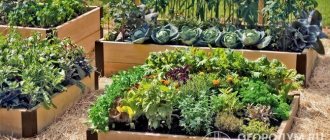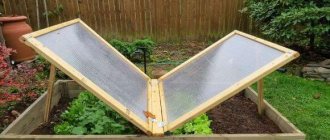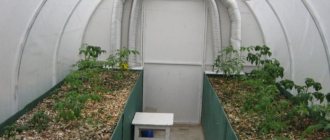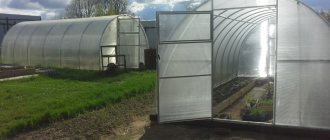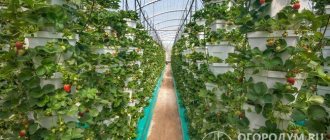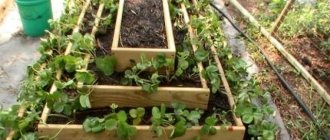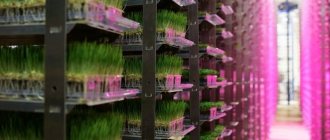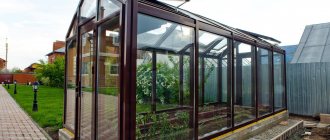The tasty and beloved berry is usually planted in the spring or, preferably, in the fall. But, of course, it is allowed to organize landing areas at any convenient time. If you plan to plant bushes directly in the year of construction of the fences, then the only condition that needs to be thought out in advance is related to being able to prepare the land by the scheduled planting dates, add the necessary fertilizers to the strawberry beds at least a week before placing the plants on the new place.
Strawberry plantations are renewed, as a rule, every 3-4 years; when planting remontant and commercial highly productive varieties, they plan for 1-2 seasons
Detailed information about the different varieties of garden strawberries and the peculiarities of their cultivation can be found in the section of our website.
Types of beds for strawberries
In order for DIY strawberry beds to bring maximum benefit, you need to choose the right place for their placement and type of structure. Good harvests are obtained in a fairly sunlit clearing, where there is no close groundwater. When arranging ridges in lowlands, there is a possibility of frost damage to plants. Strawberries react painfully to lack of light and heat.
Important! The sugar content of strawberries directly depends on the location of the garden bed. The sweet harvest is harvested only when the crop is grown in the sun.
Horizontal beds for strawberries
This type of structure for cultivating berry crops consists of low beds of a standard design, the depth of which is equal to the size of the bayonet of a shovel. No fencing is required here. The undeniable advantage of such beds is the ease of arrangement, but there is also a downside - the need for regular weeding as the seedlings grow and develop.
The passages between the rows will also need to be treated to remove weeds. There is still a risk of strawberries becoming infected with various types of diseases. As an option, you can plant bushes on cover-type ridges, also horizontal. For its production, black film material or other fiber is used that prevents the growth and development of problem plants. Despite the complexity of arranging such a bed, growing strawberries becomes a completely justified activity, and the material can last for many years.
Vertical beds for strawberries
There are many ideas for vertical strawberry beds, for example, planting seedlings in bags with slots. Pyramidal structures are very popular, for the manufacture of which antiseptic-treated boards are used. You can also use tires of different diameters to make beds for strawberries, which looks quite original. If pipes are used, then holes of the required size are made in a spiral. The advantage of vertical structures is that they save space on a personal plot and are highly decorative during the flowering and fruiting period of berry crops.
It is best to choose the south side of the gazebo or residential building or outbuilding for their placement. Thanks to this, the crop does not come into contact with the soil and does not rot. A particularly advantageous option is a multi-tiered structure made from containers filled with fertile soil. There are no weeds here, which simplifies the care of the plantings. But there is one drawback to such beds - in winter the plants may freeze, which requires placing the containers in a more suitable place.
Important! When growing strawberries in containers and flower pots, there is a need for frequent feeding procedures. This is due to the rapid leaching of useful substances from the soil.
Raised beds for strawberries in the country
German gardeners came up with such an interesting bed for strawberries. It involves the construction of boxes of certain sizes and filling them with a nutritious composition. Among the positive aspects of using high beds for berry crops are:
- exclusion of weeds;
- fast and easy manufacturing method;
- a real salvation for growing strawberries in lowlands, dimly lit places;
- no need for weeding;
- the ability to build beds at any level;
- high degree of crop productivity.
In the presence of compost, such a bed becomes warm, which further increases the efficiency of growing berry crops.
Warm beds for strawberries
This is one of the smart beds for strawberries; they are made either on the surface of the soil or in a trench. The insulated design provides for a drainage layer, a heat-generating layer and soil. Warm beds show their high efficiency in regions with a cold climate, where there is a possibility of return frosts until mid-June.
There are several types of warm beds:
- Frame, where coarse and fine plant material is placed in a box made of boards or slate. It is necessary to use this option for arranging a bed for strawberries in areas with high levels of humidity.
- Bulk, which involves digging a shallow trench and filling it with biofuel. This type of warm bed is used in areas where there is flooding with groundwater.
- Combined, combining the two previous options. Coarse plant material is placed in a trench, and fine waste is placed in a box.
When choosing a bed for strawberries, it is important to consider not only the strengths of a particular option, but also the weaknesses.
Vertical structures
Stair beds, stacked, trapezoidal, in the shape of a pyramid, round labyrinths or steps in several tiers also have their own nuances during construction. Undoubtedly, such a hill, hung with berries, looks impressive and becomes a decoration for any summer cottage. But when designing a cascade composition, you need to correctly determine the height at which the central part of the elevation will be located, and accurately calculate the width of the sides of the base. Errors in calculations can lead, for example, to the fact that with a very wide lower platform it will be difficult to reach the top of the head, which is even at a meter level, and you will have to care for the bushes in an uncomfortable semi-bent position.
Caring for plants will require increased control of soil moisture and fertility, periodic renewal and replenishment of soil washed out by rains
Due to the changing movement of the sun during the day, the shadow from the upper trays can cover not only the space nearby, but also the lower levels. When installing a beautiful vertical bed, you need to decide on the location in advance or be able to rotate and move it, which in itself is impractical and sometimes impossible. It is also important to remember that the soil in isolated containers quickly dries out, becomes depleted, and freezes through in the winter, so the structure will have to be brought indoors during the winter or the plants will have to be removed from it in the off-season.
What beds are best to make for strawberries?
To successfully cultivate a berry crop, it is necessary to create the most comfortable conditions for its growth and development in the garden:
- access of oxygen to the roots;
- normal level of humidity;
- sufficient air circulation in the bush growth zone;
- good lighting;
- soil fertility;
- eliminating the possibility of berries coming into contact with the ground.
Based on these requirements, it is best to give preference to high beds with agrofibre. This material simplifies the process of caring for the crop, prevents slugs from damaging the berries, and makes picking strawberries as comfortable as possible. In addition, an invasion of garden ants is rarely observed in high beds.
Selecting a location
Before organizing the beds, it is important to choose a good place for growing strawberries or wild strawberries. These crops grow poorly in areas of high humidity. If your land plot has very shallow groundwater, then the strawberry beds will have to be made high. Otherwise, water will constantly stagnate in the soil - and this will be the main answer to the question of why strawberries rot in the garden beds. In this case, the area you choose should be well illuminated by sunlight. A shady area is not suitable for strawberries - the berries will be small, unsweetened, and ripening will be very slow. There is a risk that strawberries will not have time to ripen at all during the summer season.
Crop rotation rules:
| After what crops should strawberries be planted? |
| Cereals (rye, corn), legumes (beans, peas, lentils). |
| Potatoes, cucumbers, tomatoes, all types of cabbage, peppers, pumpkin, zucchini, melon, watermelon, squash, eggplant |
What materials are used to make comfortable strawberry beds?
Among all the variety suitable for creating beds for berry crops, structures made from boards, barrels, tires, and slate sheets deserve special attention.
Strawberry beds made from boards
Using boards for arranging beds for berries is the best option because:
- provides favorable conditions for plant growth and development;
- seedlings in raised structures are rarely exposed to various types of diseases;
- natural material retains heat well, which is important in cold weather;
- wood does not heat up when exposed to the sun.
To create the right bed for strawberries, it is recommended to use oak, beech, larch, and ash as materials. In addition to advantages, beds made from boards also have some disadvantages:
- require some effort;
- availability of power tools and fasteners;
- there is a need for treatment with special anti-rotting preparations.
The process of making a bed for strawberries involves the following steps:
- Construction of a box for a bed for strawberries of suitable sizes using self-tapping screws.
- Installation of a wooden structure in a place where the top layer of earth was previously removed.
- Laying geotextiles and a drainage cushion made of crushed stone or small stones.
- Filling the bed with nutrients.
Bulk beds for strawberries
This technique involves forming a shallow ditch 40 cm wide and laying large branches in it first, and then small ones. After this, plant residues are used in the form of fallen leaves, mowed grass, humus, and compost. Then all layers are spilled with plenty of water, having previously compacted each one well. A fertile layer of soil is poured on top, and a bed 20-30 cm high from ground level is obtained. The edges can be left flat, or they can be fenced with boards. Use this type of bed in areas where there is no risk of groundwater flooding.
Strawberry beds from a barrel
There is an option for a strawberry bed for the lazy, where the simplest and most unnecessary things such as barrels, buckets and other containers are used. Such structures are distinguished by their mobility; if necessary, they can be moved to the desired location. To fill such beds, a soil mixture of garden soil and organic fertilizer is used. The number of seedlings planted will directly depend on the diameter of the container.
Important! To create a collapsible structure for planting berries, it is effective to use a frame made of galvanized steel. This structure is characterized by quick dismantling and ease of manufacture.
Among the positive characteristics of this bed can be noted:
- no costs for manufacturing the frame;
- high degree of warming up under the sun;
- convenience in the process of care and harvesting;
- possibility of transfer to another place;
- economical water consumption.
Despite a whole list of advantages, barrel beds also have their disadvantages:
- there is a risk of plants freezing in winter (especially in metal containers);
- there is a need for regular irrigation activities due to the rapid drying of the soil.
Beautiful strawberry beds made of slate
Almost every garden plot has remnants of slate sheets. Not only wave slate, but also flat slate is used for arranging structures for strawberries. These designs differ:
- accessibility;
- speed and ease of construction;
- long service life;
- not subject to the processes of rotting, decomposition, deterioration.
Among the disadvantages, we can only highlight the negative impact of asbestos cement, which is part of the building material, on agricultural plants. To insert slate into the ground, you will need to deepen it and additionally secure it for reliability.
The step-by-step process of building a bed for strawberries from slate is as follows:
- First, remove the top layer of soil.
- Slate sheets cut to size are buried 10-20 cm into the ground.
- The structure is strengthened by using metal corners at the corners of the bed.
- Wooden or metal pegs are driven into the ground to maintain the integrity of the structure in windy conditions.
- Finally, fill the bed with fertile soil mixture.
To simplify, the first step is to assemble a metal or wooden frame, and then install the slate sheets.
Beautiful beds for strawberries made from tires
Waste tires can also be useful when used in gardening. This is a completely affordable consumable material that does not require large areas for arranging beds for strawberries. Tires perfectly protect plants from the harmful effects of low temperatures and other adverse environmental factors. In addition, they have a rather original appearance.
The only thing that is required to create a bed for berry crops is to devote time and effort to making holes for the seedlings. A flowerbed is made taking into account the following sequence of actions.
Holes of suitable diameter should be cut in the tire. Place in prepared place. Place a metal mesh with a fine mesh inside the tire and fill it with fertile soil.
Soil preparation
It is best to start preparing the soil in the fall. It goes like this:
- First, the space required for the garden bed is completely cleared (excess vegetation, branches and debris are removed).
- The soil is loosened and the necessary fertilizers are added to it.
- Mark and place the beds.
At the stage of digging up the soil, you can mix:
- 6 kg of humus;
- 50 g of nitrogen fertilizers;
- about 80–100 g of superphosphate.
Find out more about how to grow strawberries in winter.
Acidity level control
Slightly acidic soils are ideal for strawberries, but neutral and slightly alkaline soils are also suitable. For healthy strawberry growth, the soil acidity should be 5-6 units. To reduce the acidity of the soil, it needs to be limed - add substances such as:
- slaked lime;
- ground limestone;
- dolomite flour;
- marl.
Fertilizers
The active development of strawberry bushes and fruits is ensured by mineral fertilizers. It is best to use preparations with a high content of elements such as potassium, phosphorus, and nitrogen. Manure and peat compost or humus are used as organic fertilizers. You can fertilize the soil as follows: add 10 g of potassium chloride to the dug up soil at the rate of every 1 m², with the addition of 30 g of superphosphate.
How to prepare a bed for strawberries
To achieve the desired result when cultivating berry crops, you should know at what distance to build structures, what size they should be and at what depth to build them.
Distance between strawberry beds
If you are planning beds in the southern regions on flat terrain, both a recessed version (trench) and a raised version, where wooden boxes with black fabric are used, are suitable. When growing strawberries in temperate climates, the height is 15-20 cm.
The optimal solution is the width of the structure for planting seedlings is 50 cm. With this approach, it is permissible to place strawberries in two rows, maintaining an interval between them of 30-35 cm. It is more advisable to place seedlings in a checkerboard pattern for better air circulation. In general, the distance between bushes in a row depends on the characteristics of the variety being grown, but in most cases it ranges from 20 cm.
It is possible to provide a passage between the beds in any order, at least it is 35 cm. The main requirement for the paths is convenience for the gardener to move; there should be no discomfort when watering, weeding and adding nutrient mixtures. If you need a garden wheelbarrow or other equipment to pass between the beds, then maintain a distance of 65 cm. If there are a large number of plants, you can plant them 2 times denser (in one row), but after the first fruiting, the plantings should be thinned out by removing them through one bush. Thanks to this simple technique, it is possible to increase yields in the first year of planting strawberries. You cannot plant more than one plant in one planting nest.
Strawberry bed size
The ideal option for making a bed for strawberries is 80 cm wide and as long as the space on your personal plot allows. In this case, planting is carried out taking into account the placement of seedlings in 2 rows, where the distance between them is 40 cm. If the structure is made under one row, then the width of the strawberry bed is 20 cm and the interval between the bushes is also 40 cm. You can plan the beds according to individual parameters, the main thing is not to neglect the distance between plants.
Strawberry bed depth
To achieve a large and tasty harvest, experienced gardeners recommend observing the following parameters when planting seedlings:
- The direction of the beds should be from east to west, which will eliminate the lack of sunlight. This way the bushes will not shade each other.
- The height of low structures with sides should be in the range of 20-40 cm, and for high structures with walls this value should be no more than 90 cm.
- The depth of digging the soil in the area for strawberries is 30-40 cm, this is quite enough for normal growth and development of the underground part of the bush. Dig up the ground using a pitchfork or an ordinary garden shovel. Preparatory measures should be taken in the fall, but if necessary, they can also be done in the spring. If the site has loamy soil, then sand, sawdust or peat are used to increase its fertility. Sandy soil is generally not suitable for cultivating garden strawberries, so in such cases high beds are made using a nutrient composition.
Important! Maintaining the optimal distance between bushes is the key to a bountiful harvest. By saving space, the growth of garden strawberries stops, the likelihood of them being damaged by pathogenic microorganisms increases, and the weeding process becomes more complicated.
How to determine the optimal height, width and length
The width should be such that it is possible to process, thin out, replant, water and feed plants without difficulty or unnecessary manipulation. Typically, the standard value of up to 50 cm allows you to reach with your hand or tool almost to the opposite edge, rather than going around the bed from different sides to do this. This distance is convenient both for holes dug in one row and for two-line planting.
The height and length of the fences are chosen arbitrarily depending on the area and location of the site, and the personal preferences of the owners
Based on the size of the site, stripes are made both meter and ten meter. 50-60 cm wide passages are left between the rows so that a garden wheelbarrow can pass through them freely and a small stool can be placed for a break while working.
How to make beds for strawberries with your own hands
You can prepare a bed for strawberries in both spring and autumn. It is best to choose warm structures for growing berries, which are improved compost heaps. Making such a unique bed is quite simple, the main thing is to adhere to the following sequence of actions:
- Dig a trench 40-60 cm deep.
- Install a wooden box; you can also use slate sheets, another available consumable.
- Place a metal mesh at the bottom, which will protect the garden strawberry seedlings from rodents.
- The next step is to lay a drainage cushion made of stones and broken bricks.
- After this, lay down coarse plant material in the form of large tree trunks.
- Then the wooden box is filled with plant debris: fallen leaves, weeds, tops, kitchen waste.
- A layer of fertile soil is laid on top and mulched with straw and mown grass.
- The bed is finally watered with water, taking into account 70 liters per 1 sq.m.
Important! To avoid future problems with garden strawberries, you need to use only healthy plant materials, without signs of disease or rot, to fill a warm bed.
Photos of warm beds for strawberries, made with your own hands, are presented below.
Warm
Such a bed is usually fenced with boards or other building materials. Inside it is filled with organic raw materials - manure, hay, grass, compost. These materials emit heat during decomposition, which is why such beds are called warm. The height of the organic layer is up to 40 cm.
Important! Without timely watering, warm organic beds will not be effective.
| pros | Minuses |
| Thanks to the fences, soil and compost do not spill down the aisle | High cost of buildings |
| Good fertilizer | This method is not suitable for hot climates. |
| Rodent protection |
Technology for planting strawberries in beds
The optimal time for planting is spring, when the air warms up to at least 10-15 degrees. It all depends on the region and climatic conditions. If strawberries are grown in Siberia, then it is recommended to plant the bushes in the second half of May, and in regions with a warm climate - in April. If seedlings are planted in the fall, it should be planned for late summer to mid-autumn.
But it is more effective to carry out planting activities in the spring than in the fall, so the bushes have time to form a strong root system. In regions with little snow in winters, garden strawberries are planted in the spring in areas with good lighting and protection from draft winds.
Important! The best time to plant strawberry seedlings is evening or cloudy day.
The planting technology includes:
- Carrying out markings on the black mulching cloth. For convenience, use a long cord stained with chalk.
- In the designated places, using sharp scissors or a knife, make cross-shaped cuts about 10 cm long. You should not make them very large, otherwise weeds will sprout around the bush and clog them. The distance between strawberries when planting in a bed where black material is used is 30 cm.
- Prepared young plants with a healthy root system are planted in the holes made. After this, they are watered with settled water. It is recommended to tuck the resulting corners in the place where the strawberries are planted, carefully burying them into the soil. The main condition is that the outlet must be above ground level.
If the bed is formed according to the standard scheme, without covering material, then after digging the ground is leveled, nitroammophoska is added at the rate of 10 g of the product per planting, and the soil is allowed to settle for 3-7 days. After this, the locations of future holes are outlined.
Planting nests should be spacious so that the root system does not experience discomfort and is free. Before planting, seedlings are prepared by cutting the roots to a length of 5-6 cm, which will stimulate the growth of new roots. In addition, you need to leave 2-3 small leaves and a heart on the bushes, and remove the rest of the green mass. Such measures are necessary for better rooting of strawberries.
The seedling should be placed in the planting nest strictly in an upright position, after which it should be carefully sprinkled with fertile soil. To make the work easier, use a spatula or trowel, which is inserted to a depth of 15 cm near the marking cord. You can also mulch your plantings with organic material, but it needs to be updated annually. It is more expedient to use non-woven fabric for these purposes. Only an integrated approach allows for rapid rooting of young seedlings.
Saving berries from birds
Another problem with strawberries is birds. They are very attracted to the red color of the berries. And one fine morning you can find berries in the garden that have been thoroughly pecked by birds. To save the crop, you can cover it at night with the thinnest covering material.
This, of course, will require even additional effort, since you can’t just put covering material on the bushes. We'll have to make arcs for it. To do this, you can buy an insulated electrical wire with a diameter of 6 mm, cut sections of it longer than the width of the bed to form an arc, bend these sections into an arc and throw them over the beds at a distance of 50 cm.
And already throw a light covering material over these arches. It is important to secure it at the edges of the bed with pebbles or pieces of wood so that it does not fly away when there is a gust of wind.
Ready-made arcs are also sold in garden stores. This method of saving berries from birds will also provide the berries with warm nights: even under the lightest covering material it is warmer at night.
Design options for strawberry beds
Making interesting beds for garden strawberries in your garden plot is not as difficult as it might seem at first. The main thing is that the intended design fits effectively into the overall design.
If the plot is small, then a good solution would be to use vertical beds. They do not require much space, are easy to implement and do not cause trouble in the process of growing berries.
When choosing the configuration of a specific structure for garden strawberries, you should take into account the dimensions of the area allocated for these purposes. If the planting area is long and narrow, then round-shaped structures are not recommended.
The original option is to use galvanized steel with a polymer coating. This material has a long service life, the design looks quite interesting. A structure made of stones will be durable and beautiful, but it will require some experience when laying them. The simplest and most affordable way to design beds for strawberries is considered to be border tape.
For greater effect, the paths between the structures can be sprinkled with small decorative stones or covered with paving slabs.
Multi-tiered beds in the shape of a pyramid look very stylish. Boards, metal, and plastic are suitable for their manufacture. It is also good to use fragments from sewer pipes, flower containers, tires, and vegetable or fruit boxes. The configuration can be very diverse: rectangular, round, polygonal, wavy. There is room for imagination here.
Photos of original do-it-yourself strawberry beds are presented below.
Hanging containers
Although planting rosettes in small containers serves mostly a decorative purpose, with proper care, a certain harvest can be harvested on such “air” plantations.
Strawberry bushes in hanging flower pots look very impressive and original
Before mounting and hanging compact, land-efficient baskets and elongated boxes on hooks or brackets, you need to make sure the strength and stability of the support: wall, fence, beams, in order to avoid possible collapse due to wind load, excessive weight of the containers together with the contents and amount of irrigation or rainwater. The frame of the containers must be strong and rigid, the fastening (bolts, dowels-nails) must be reliable.
Possible mistakes
Remontant strawberries produce few tendrils unless the flowers are picked off. To quickly propagate the variety, at 1 year the buds are cut off and the harvest is sacrificed.
In the spring, the ridge is set up in an area cleared of leaves and branches. This will help avoid contamination of the soil with rot.
To ensure a good harvest in the first year of planting, the soil is fertilized with an organic composition: humus, bird droppings or rotted manure.
Thick planting reduces plant development. Yields also decrease.
Furrows between rows remove excess moisture. This method helps get rid of root rot.
Mulching
The mulching process consists of covering the soil of plants with organic materials or agrofibre. This will save strawberries from the effects of such negative factors as:
- pests;
- pollution;
- drying out;
- illness;
- weeds.
Coating with covering material
Covering material is easy to find in specialized stores. It comes in two types: polyethylene film and non-woven material. Polyethylene film for mulching can be:
- white;
- black;
- two-color.
